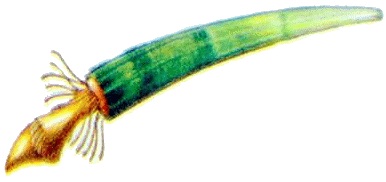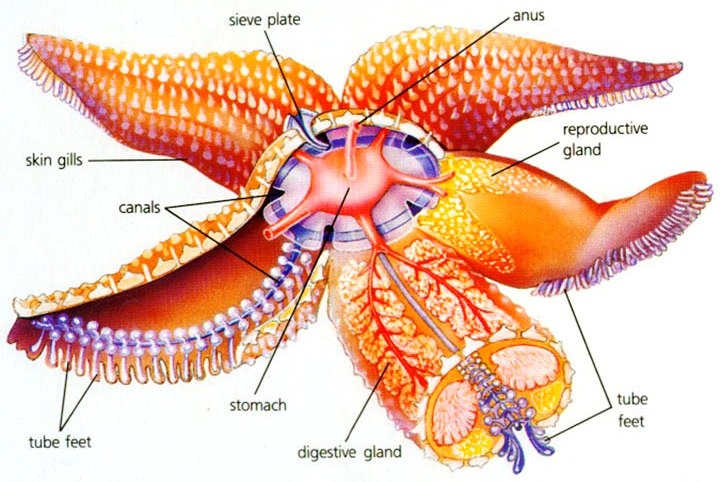Phylum Mollusca and Echinodermata
Table of Content |
|
|
Phylum Mollusca

 - Basically bilateral and protostomial eucoelomate eumetazoans whose soft body (L., mollis or molluscum = soft) is unsegmented and enclosed within a skin–fold (mantle) which usually secretes a calcareous shell.
- Basically bilateral and protostomial eucoelomate eumetazoans whose soft body (L., mollis or molluscum = soft) is unsegmented and enclosed within a skin–fold (mantle) which usually secretes a calcareous shell.
- About 80,000 existing and 35,000 extinct species known. Aquatic or terrestrial.
- Snails and mussels found along banks of freshwater bodies and the oysters, shanks (shoes conch–shell is commonly blown in religious ceremonies) and cowries of the sea are common molluscs.
Malacology or Conchology is the branch of study of molluscs and their shells.
Molluscs are of some economic importance; man uses some as food; shells of some are used for making buttons, beads, etc.
Brief History
Aristotle described a number of molluscs. Johnston (1650) proposed the name of the phylum.
Salient Features
(1) Molluscs are multicellular organisms
(2) They have a bilateral symmetry, but snails are asymmetrical
(3) They are triploblastic animals.
(4) They are coelomate animals. True coelom is reduced the haemocoel is well developed in them.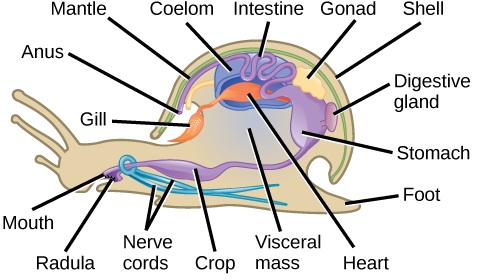
(5) They have organ system grade of organization.
(6) The body is soft and unsegmented.
(7) The soft body is covered by a fleshy fold of the body wall. It is called mantle.
(8) The molluscs are provided with one or two calcareous shells. The shells may be external or internal.
(9) Respiration is carried out by the gills or pulmonary chambers.
(10) The digestive system is well developed. It contains a radula and a hepatopancreas.
(11) The circulatory system is of an open type.
(12) The excretory organ is the kidney.
(13) The nervous system is well developed.
(14) The sensory organs are eyes, statocysts and osphradia.
(15) Sexes are separate in them, or they are hermaphrodites.
(16) The development in their case in either direct or indirect
Classification of Mollusca
Class 1. Aplacophora or Solenogasters
(1) The body is worm–like, bilaterally symmetrical and cylindrical.
(2) The head, mantle, foot, shell and nephridia are absent.
(3) The body is covered with spicule–bearing cuticle.
(4) The digestive tract is straight with radula.
(5) A mid dorsal longitudinal keel or crest is often present .
(6) Example : Neomenia, Chaetoderma, etc.,
Class 2. Monoplacophora
(1) The body is bilaterally symmetrical and segmented.
(2) The shell is formed of a single valve.
(3) The head is without eyes and tentacles.
(4) The gills are external and serially arranged.
(5) The nephridia are five pairs.
(6) Example : Neopilina galatheae
|
Class 3. Polyplacophora
(1) These molluscs are bilaterally symmetrical, and dorsoventrally flattened.
(2) The shell is composed of a longitudinal series of 8 plates.
(3) The foot is flat and ventral.
(4) The radula is well developed.
(5) Example : Chiton, Cryptochiton, etc.
Class 4. Gastropoda
(1) It seems that these animals are moving on their stomach. Hence the name gastropoda.
(2) Gastropods are marine, fresh water or terrestrial animals. A few are parasitic.
(3) The body is unsegmented and asymmetrical.
(4) The shell is univalve and spirally coiled.
(5) The head is distinct. It bears tentacles, eyes and a mouth.
(6) The foot is ventral and muscular.
(7) The buccal cavity is provided with a radula.
(8) The circulatory system is open.
(9) The sexes are mostly separate, while some forms are hermaphrodite.
(10) The development includes veliger and trochophore larvae.
(11) Examples : Haliotis, Cypraea (Cowrie) Pila (apple snail), Murex (rock shell) Aplysea (sea hare etc), Doris (Sea Lemon)
Class 5. Scaphopoda
(2) The eyes, the tentacles and ctenidia are absent.
(3) Marine, bilaterally symmetrical molluscs.
(4) Examples : Dentalium, Siphonodentalium and Pulsellum
Class 6. Pelecypoda
(1) Pelecypoda are aquatic in habit.
(2) The body is bilaterally symmetrical and laterally compressed.
(3) The shell is formed of two distinctive shell plates.
(4) The head is not distinct.
(5) The alimentary canal shows a crystalline style.
(6) The gills, excretory organs and the other structures are paired.
(7) The sexes are separate or united.
(8) The development is indirect having a glochidium larva.
(9) Example : Mytilus, Unio, Tredo.
Class 7. Cephalopoda
(1) The body is bilaterally symmetrical.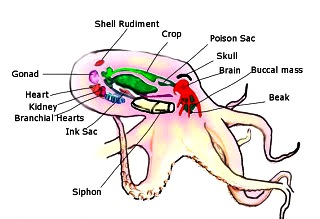
(2) The foot is modified into arms and funnel.
(3) The shell may be either absent or rudimentary; it may be internal or external.
(4) The odonotophore with a radula is present.
(5) The ink–gland is present.
(6) The sexes are separate.
(7) The development is direct hence no metamorphosis and larval stage.
(8) Example : Nautilus, Loligo Sepia, Octopus
Question 1: Octopus belongs to class
(a) Mollusca
(b) Pelecypoda
(c) Arthropoda
(d) Cephalopoda
Question 2: Mytilus belongs to class
(a) Amphineura
(b) Arthropoda
(c) Echinodermata
(d) Pelecypoda
Question 3: Unio have
(a) One chambered heart
(b) Two chambered heart
(c) Three chambered heart
(d) No heart
Question 4: Foot is displaced to the neighbourhood of mouth and divided into arms in
(a) Ostrea
(b) Pila
(c) Sepia
(d) Chiton
Question 5: Most mollusc are
(a) Terrestrial
(b) Fresh water
(c) Marine


| Q.1 | Q.2 | Q.3 | Q.4 | Q.5 |
| d | d | c | c | c |
Phylum Echinodermata
 - Bilateral and deuterostomial eucoelomate eumetazoa with rough, tough and leathery skin due to dermal skeleton of usually spiny, calcareous ossicles; and the basic bilateral symmetry of larva modified, in the adult, to a pentamerous radial symmetry.
- Bilateral and deuterostomial eucoelomate eumetazoa with rough, tough and leathery skin due to dermal skeleton of usually spiny, calcareous ossicles; and the basic bilateral symmetry of larva modified, in the adult, to a pentamerous radial symmetry.
- The term “Echinodermata” means spiny skin (Gr., echinos = spiny + dermatos = skin).
- About 6,000 living and 20,00 extinct species known.
Brief History
- Although Jacob Klein (1738) had earlier coined the name “Echinodermata”, yet Linnaeus included these animals under “Mollusca”, and Lamarck under his class “Radiata” as “Echinodermes”.
- Finally, Leuckart (1847) raised the group to the status of a separate phylum.
Salient features
(1) Echinoderms are exclusively marine beings.
(2) They are triplobalstic and coelomate animals.
(3) They have radially symmetrical body. The radial symmetry is due to sedentary or sessile mode of life and it is a secondary character in echinoderms.
(4) They have organ system grade of organization.
(5) They have well developed endoskeleton formed of calcareous ossicles and spines.
(6) They have a water–vascular system with tube–feet for locomotion, feeding and respiration.
(7) Circulatory system is of the open–type.
(8) The sensory organs are poorly developed.
(9) The excretory organs are absent.
(11) Development is indirect.
(12) The larval forms are bilaterally symmetrical.
(13) Regeneration power is well developed in Echinoderms.
(14) Water vascular system found in echinodermata
Classification of Echinodermata
Subphylum I. Eleutherozoa : Free-living echinoderms.
Class 1. Asteroidea
(2) Arms 5 or more and not sharply marked off from the central disc.
(3) Tube feet in orally placed ambulacral grooves; with suckers.
(4) Anus and madreporite aboral.
(5) Pedicellariae present.
(6) Free-living, slow-creeping, predaceous and scavengerous.
(7) Examples : Astropecten, Luidia, Goniaster, Oreaster (= Pentaceros), Asterina, Solaster, Pteraster, Echinaster.
Class 2. Ophiuroidea
(1) Brittle-stars and allies.
(2) Body star-like with arms sharply marked off from the central disc.
(4) Stomach sac-like; no anus.
(5) Ambulacral grooves absent or covered by ossicles; tube feet without suckers.
(6) Madreporite oral.
(7) Examples : Ophiura, Ophiothrix, Ophioderma, Ophiopholis, Gorgonocephalus (basket star), Asteronyx.
Class 3. Echinoidea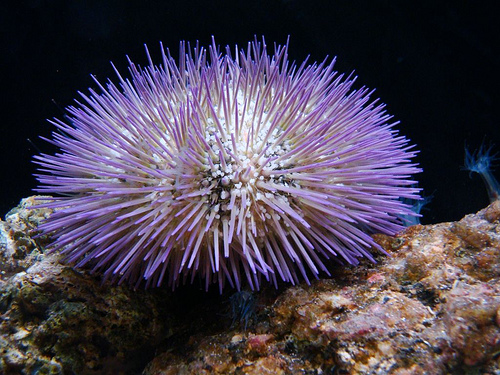
(1) Body not divided into arms; globular (sea urchins), or flattened disc-like (sea-cakes).
(2) Mouth at lower pole, covered by 5 strong and sharp teeth, forming a biting and chewing apparatus called “Aristotle's Lantern”.
(3) Tube-feet slender with suckers.
(4) Skin ossicles fused to form a rigid globular, disc like, or heart-shaped shell or test with movable spines.
(5) 3–jawed pedicellariae present in skin.
(6) Gut long, slender and coiled. Anus present.
(7) Larval forms pluteus and Echinopluteus.
(8) Examples : Sea urchins and sand dollars.etc.
Class 4. Holothuroidea
(1) Body massive, long and cylindrical like a cucumber; elongated in oral–aboral axis; no arms.
(2) Mouth at anterior and anus at posterior ends.
(3) Mouth surrounded by many hollow retractile tentacles.
(4) Tube feet usually present; sucker-like.
(5) Skin leathery, but relatively soft, without spines or pedicellariae; may have an endoskeleton of miniute calcareous ossicles.
(6) Respiration and excretion by two long and highly branched tubes (= respiratory tree) extending into coelom from cloaca.
(7) Larval form Auricularia.
(8) Examples : Holothuria, Cucumaria etc.
Subphylum II. Pelmatozoa
Stalked, sedentary echinoderms.
Class 5. Crinoidea
(1) Body flattened and pentamerous; distinguished into a small and circular central disc and five or more (in multiples of five) long, then, branched and flexible arms radiating from the disc.
(2) Disc enclosed in a hard, cup–shaped calyx formed of calcareous plates; calyx attached to a substratum by a stalk or simply by its aboral surface.
(3) Mouth in middle and anus excentral upon a cone, both upon oral surface. 5 ambulacral grooves run from mouth upto the tips of the arms.
(4) Tube feet sucker–like; restricted to central disc; can help in food–collection.
(5) Some forms (sea–lilies) permanently sessile and attached to sea–bottom by a long stalk; others (feather stars) free-swimming, but have flexible cirri for gripping objects in water.
(6) Spines and pedicellariae absent in skin.
(7) Examples : Sea lilies and Feather stars (Antedon)
Question 1: In echinodermata, tube feet are related with
(a) Excretory system
(b) Ambulacral system
(c) Reproductive system
(d) Respiratory system
Question 2: Aristotle's lantern is found in
(a) Jelly fish
(b) Sea anemone
(c) Sea lily
(d) Sea urchin
Question 3: The term not applicable to echinodermata
(a) Madreporite
(b) Podia
(c) Marine
(d) Bilateral symmetry
Question 4: Water vascular system (ambulacral system) is typically found in
(a) Hydra
(b) Sponge
(c) Earthworm
(d) Star fish
Question 5: Main function of pedicellariae in Asterias is
(a) Digestion
(b) Excretion
(c) Respiration
(d) Capture of prey and removal of debris


| Q.1 | Q.2 | Q.3 | Q.4 | Q.5 |
| b | d | d | d | d |
Related Resources
-
Click here to refer the Useful Books of Biology for NEET (AIPMT)
-
Click here for study material on Anatomy of Flowering Plants
To read more, Buy study materials of Animal Kingdom comprising study notes, revision notes, video lectures, previous year solved questions etc. Also browse for more study materials on Biology here.
View courses by askIITians


Design classes One-on-One in your own way with Top IITians/Medical Professionals
Click Here Know More

Complete Self Study Package designed by Industry Leading Experts
Click Here Know More

Live 1-1 coding classes to unleash the Creator in your Child
Click Here Know More

a Complete All-in-One Study package Fully Loaded inside a Tablet!
Click Here Know MoreAsk a Doubt
Get your questions answered by the expert for free


